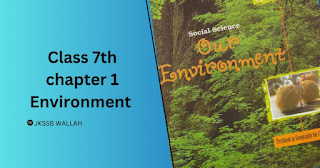class 7 geography chapter 1 question answer
Q 1. Answer the following questions.
(i) What is an ecosystem?
Ans: An ecosystem is the system where living organisms interact with each other and their environment, including physical and chemical factors. It is characterized by the transfer of energy and materials within the system.
(ii) What do you mean by natural environment?
Ans: The natural environment consists of the fundamental components and organisms that exist in a given area without human intervention. These components include the land, water, air, plants, and animals that naturally occur in the environment.
(iii) Which are the major components of the environment?
Ans: The environment consists of various components, which can be categorized into three main groups:
1. Natural Components: These are elements that occur naturally in the environment and include air, water, land (such as mountains, forests, and deserts), and living things (plants, animals, microorganisms, etc.).
2. Human-made Components: These are components that are created or modified by human beings. Examples include buildings, roads, bridges, dams, and other infrastructure, as well as agricultural fields, industrial areas, and urban settlements.
3. Human Components: This refers to the human populations inhabiting the environment. It includes factors such as population size, density, distribution, cultural practices, economic activities, and social dynamics.
These components collectively interact and influence the overall state and functioning of the environment.
(iv) Give four examples of a human-made environment.
Ans: Examples of the human-made environment include buildings, parks, industries, and bridges.
(v) What is lithosphere?
Ans: The solid outer layer of the Earth, known as the lithosphere, consists of rocks and minerals. It is overlaid by a thin layer of soil. The lithosphere exhibits an uneven surface with diverse landforms, including mountains, plateaus, and plains.
(vi) Which are the two major components of the biotic environment?
Ans: Plants and animals are the two major components of the biotic environment
(vii) What is a biosphere?
Ans: The biosphere, also known as the living world, is a narrow zone on Earth where land, water, and air intersect to sustain life. It encompasses the plant and animal kingdoms, representing the diverse array of life forms within this interconnected ecosystem.
Q 2. Tick the correct answer.
(i) Which is not a natural ecosystem?
(a) Desert
(b) Aquarium
(c) Forest
Answer: b) Aquarium
(ii) Which is not a component of the human environment?
(a) Land
(b) Religion
(c) Community
Answer: a) Land
(iii) Which is a human-made environment?
(a) Mountain
(b) Sea
(c) Road
Answer: c) Road
(iv) Which is a threat to the environment?
(a) Growing plant
(b) Growing population
(c) Growing crops
Answer: b) Growing population
Q 3. Match the following
| (i) Biosphere | (a) blanket of air which surrounds the earth |
| (ii) Atmosphere | (b) domain of water |
| (iii) Hydrosphere | (c) gravitational force of the earth |
| (iv) Environment | (d) our surroundings |
| (e) narrow zone where the land water and the air interacts | |
| (f) relation between the organisms and their surroundings |
Answer:
| (i) Biosphere | (e) narrow zone where the land water and the air interacts |
| (ii) Atmosphere | (a) blanket of air which surrounds the earth |
| (iii) Hydrosphere | (b) domain of water |
| (iv) Environment | (d) our surroundings |
Q 4. Give reasons.
(i) Man modifies his environment.
Ans: Humans, in order to meet their basic needs, modify their environment, which serves as their fundamental life support system. They construct houses for shelter and industries for work, thereby altering the environment and utilizing its mineral resources. However, the exploitation of fossils and other resources for human development has disrupted ecological systems and animal habitats.
(ii) Plants and animals depend on each other.
Ans: Plants and animals exhibit interdependence as plants act as producers, while animals serve as consumers. Through photosynthesis, plants release oxygen into the atmosphere, which is vital for human respiration. Conversely, humans exhale carbon dioxide, which is essential for plants to produce their own food through photosynthesis. This symbiotic relationship highlights the interconnectedness and mutual reliance between plants and animals in the ecosystem.

